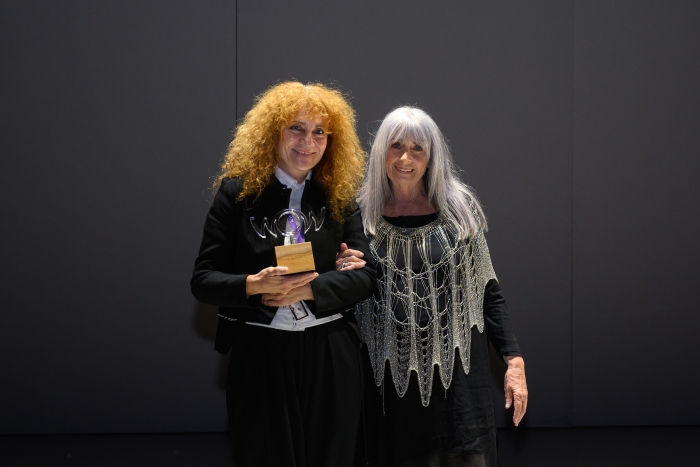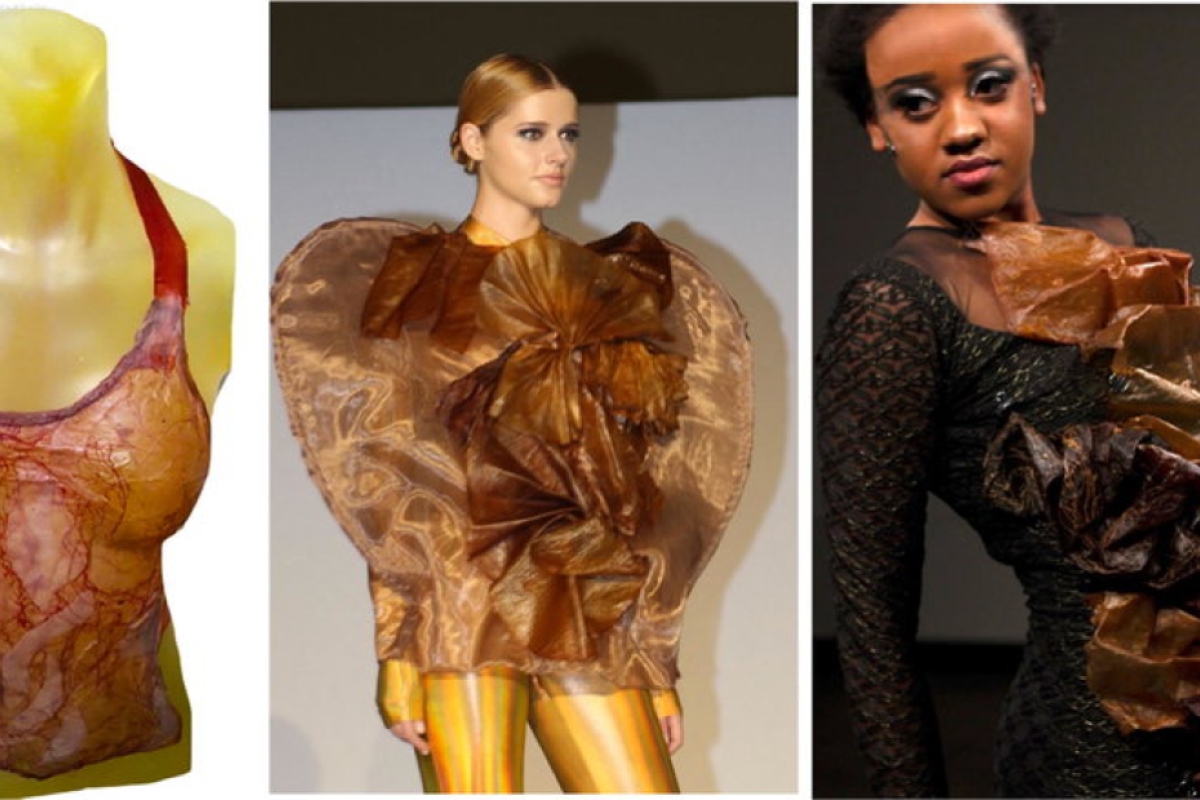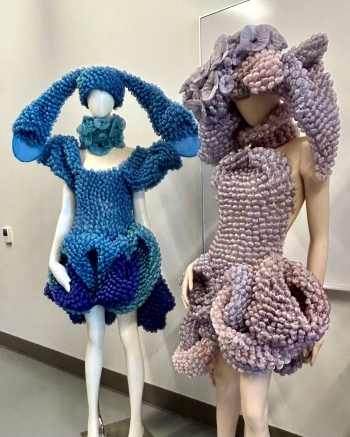ASU FIDM professor wins international award for fantastical, sustainable creation

Galina Mihaleva, associate professor at ASU FIDM, created the "Evolutionary Drone Hybrid" garment, shown here on stage, with her friend, Phoenix photographer Chris Loomis. She won the WOW Designer Development Award at the World of Wearableart competition in New Zealand recently. Photo courtesy of ASU FIDM
The horror of an ailing Earth inspired an Arizona State University fashion professor to create a fantastical garment out of sustainable, re-used and found materials that won a prestigious international prize recently.
Galina Mihaleva, associate professor at ASU FIDM, is committed to making the fashion industry more sustainable.
“I always think, as a fashion designer, how we constantly pollute,” she said.
“So a lot of my initiatives are about sustainable fashion using polyester made from plastic bottles.”
The dire predictions about plastic in the environment gave her an idea.
Illuminating the Future: Sustainable Fashion at Canal Convergence
Galina Mihaleva's students in her Materials and Techniques course will display their creations at Canal Convergence at 7 p.m. Monday, Nov. 11, in the Nationwide innovation zone at the Scottsdale Waterfront.
“It could lead us to look for another planet,” she said.
“So that's how I thought, what if on this other planet we transform to these creatures that are bionic, mechanic?”
For her creation, “Evolutionary Drone Hybrid,” Mihaleva won the WOW Designer Development Award at the World of Wearableart competition in New Zealand recently. The competition and show are held annually in Wellington, drawing top artists from around the world.
“The WOW designers, they're very different than just the fashion designers. They could be engineers, architects, people from different walks of life that unleash their creativity,” she said.
Mihaleva had submitted garments to the competition before, and a few were chosen to be displayed in the WOW museum. But she had never been a finalist until this year.
The competition’s main event is a stage presentation, and the top designs are presented in a show that’s part runway and part circus. "Evolutionary Drone Hybrid" was dramatically modeled by a dancer, who stomped and swayed across the stage.
“I saw how our creature got near the people and their faces. Some of them got so shocked, some of them laughed,” she said.
WOW had selected two of Mihaleva’s garments in the first round of judging, but eliminated one of them in a later round.
“It was felted wool, which they thought would not be durable for the performances,” she said.
For "Evolutionary Drone Hybrid," Mihaleva found two pieces of wood in her backyard that became the arms. She thrifted a children’s jacket, from which she created the padding in the joints of the garment.
“I still wanted it to be like couture. So I put this extension in the back, which was wool knit that I stitched by hand to create this kind of beautiful formation between nature and something synthetic,” she said.
Then she incorporated the Japanese art of “kintsugi” — repairing something broken using gold to make it more beautiful than it was originally.
“I used this golden wire that I wrapped with golden fabric,” she said.
“I thought in this broken world, we can add this line of gold that can put together the mechanical and the bionic.
“So everything was very symbolic.”
"Evolutionary Drone Hybrid" was described as “a representation of adaption evolution” in the Crazy Curiosities of the Creature Carnival section.
The Development Award honors designers who fuse technology with traditional craft, which is Mihaleva’s specialty. In her studio at Fusion on First on the Downtown Phoenix campus, she creates plastic alternatives from kombucha and a beautiful “leather” made from fish skin in a process she learned in Iceland.
To make the fish leather, she buys a salmon filet, removes the skin, “cures” it in egg yolk and oil, scrapes off the fat and smokes it. Amazingly, that process produces a lightweight leather with no odor. Then she dyes it with natural pigments from coffee beans or turmeric.
The resulting pieces are not large, so she connects them through a system of interlocking tabs to make a dress.
“This is modular and sustainable because if you get tired of it, you can make something else. You can constantly reuse the shapes,” she said.
Mihaleva teaches her innovations at ASU FIDM in a course called Materials and Techniques.
“I always blur tradition with technology and radical materials," she said. "A lot of them are based on bioplastic, which is biodegradable and sustainable.”
Some of her previous collections have combined technology such as 3D-printing and laser cutting with techniques such as hand painting, hand manipulation of fabric and hand sewing.
Soon, Mihaleva will send six garments to the Fellini Foundation for Cinema in Italy, which showcases the work of Italian film director and screenwriter Federico Fellini, for an exhibition next year. The dresses are created from polyester made from recycled plastic bottles. The “bubble” shapes are made by tying the fabric around marbles and steaming it.
The dresses have elaborate headpieces, inspired by the winged cornets of nuns’ habits.
“In his movie ‘Roma,’ Fellini makes fun of the religious figures,” she explained.
Mihaleva is already thinking about next year’s WOW competition, which will have the theme of “air.”
“When I was student, I was so poor. So I collected old parachutes and I made my collection from parachutes,” she said.
“And now I'm thinking I want to make something very cool using the parachutes.”
More Arts, humanities and education

Pen Project helps unlock writing talent for incarcerated writers
It’s a typical Monday afternoon and Lance Graham is on his way to the Arizona State Prison in Goodyear.It’s a familiar scene. Graham has been in prison before.“I feel comfortable in prison because of…

Phoenix civil rights activists highlighted in ASU professor’s latest book
As Phoenix began to grow following WWII, residents from other parts of the country moving to the area often brought with them Jim Crow practices. Racism in the Valley abounded, and one family at…

Happy mistake: Computer error brings ASU Online, on-campus students together to break new ground in research
Every Thursday, a large group of students gathers in the Teotihuacan Research Laboratory (TeoLab) in the basement of the School of Human Evolution and Social Change building on Arizona…




